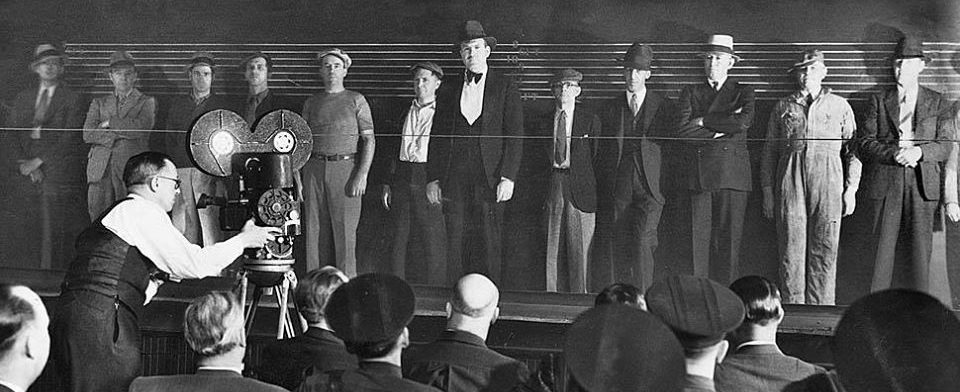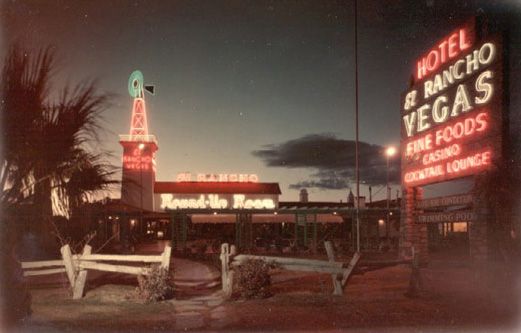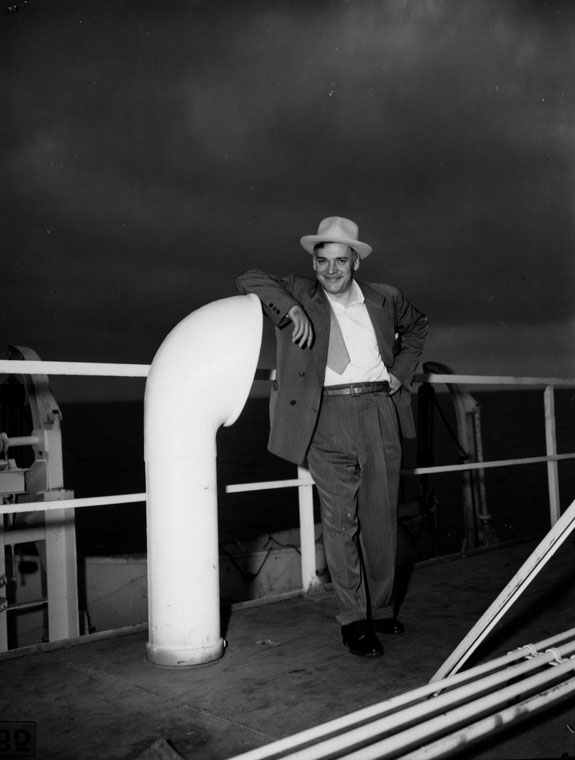
The film Bugsy, released in 1991, based on Dean Jennings’ 1967 book We Only Kill Each Other, depicts the life of Bugsy Siegel. The film looks beautiful and it’s always nice to see 1940s Los Angeles recreated, but like the source material itself, it is rather loose with the facts. No one expects a documentary, but if films use real historical figures and supposed real-life events, they really shouldn’t bend the truth. Better to just change the names and have it be fictional, as in the 1950 film noir 711 Ocean Drive.
The biggest deviations from the truth are in the timeline of events. Some characters are sort of melded with real-life persons and fictionalized. And the motive for the murder, presented as truth, is really only speculation. It’s a 1991 film but nevertheless, if anyone hasn’t seen it you are hearby warned that spoilers follow!
The film opens in Winter of what is apparently c. 1940-1941 with Siegel leaving the wife and kids behind while he makes a brief trip to Los Angeles to take over the gambling rackets of Jack Dragna.
As I wrote in my previous post, Bugsy Siegel in LA Pt. 1, Siegel had made at least two known trips to LA with Esta and family in the early 1930s. The California Crime Commission, formed by Governor Earl Warren in October 1947 as a result in part of the Siegel murder, would later state that he settled in LA with his family full time in 1937.
Seeing Siegel off on the train are Charles Luciano and Meyer Lansky, Joey Adonis, etc. These are real persons. However, Luciano at this time was in New York state prison serving time for his 1936 conviction for compulsory prostiution. Harry Greenberg approaches Siegel to ask for more money, implying that he may “sing” if he doesn’t get it. In real life, “Big Greenie” was murdered in Hollywood in November 1939. This character seems to be a blend of Greenbaum and Abe Relles, another Murder Inc. hitman, who had turned informant. See my previous post on Greenberg.
The “boys” remind Bugsy that Dragna “has been running the California rackets for 20 years with no competition.” “Except for Mickey Cohen.”
Dragna had come to LA from New York in 1914 after being suspected in the murder of “chicken king” Baret Baff. He did time in California’s San Quentin prison for “Black Hand” style extortion and was extradited to New York in 1917 where he served time in prison for the Baff murder. He returned to LA in 1919 and worked for Italian crime boss Joe Ardizzone. He took over for Ardizzone after Ardizzone’s mysterious vanishing on October 15, 1931 and around 1933, according to LAPD records compiled for the Crime Commission, muscled in on the gambling rackets of LA’s non-Italian underworld boss Guy McAfee. In a similar fashion, McAfee took over the rackets of his former boss, Charles Crawford, who was murdered in his Sunset Boulevard office along with journalist Herbert Spencer in May 1931.
Cohen’s importance is likewise overstated. Mostly because information on Cohen comes from Cohen himself and biographers accept his version of events as fact. In reality, Cohen was Siegel’s hired muscle and bagman. The Crime Commission wrote in its third report of January 31, 1950 that the importance of Cohen was “minimal” during Siegel’s lifetime.
The US Senate Crime Committee later agreed. The committee chair Sen. Estes Kefauver opined that while Cohen was involved in a lot of matters, he was no “big shot” on a national scale and “pretty far down the line” even among West Coast racketeers.
So Bugsy arrives in LA where he is picked up at Union Station by his actor pal George Raft.

Union Station opened in 1939, replacing several older railroad stations. Read my post on the earlier stations here.

They drive to the studio (presumably Warner Brothers in Burbank) where George is filming the movie Manpower with Marlene Dietrich. Manpower, which also starred Edward G. Robinson, was a real movie, release in Los Angeles in July 1941. Siegel meets Virginia Hill on the set in 1991’s Bugsy. Hill does have a bit part in the film. She plays a hatcheck girl and is costumed in a black uniform, not a fancy gown like Annette Benning’s Virginia Hill wears in Bugsy.
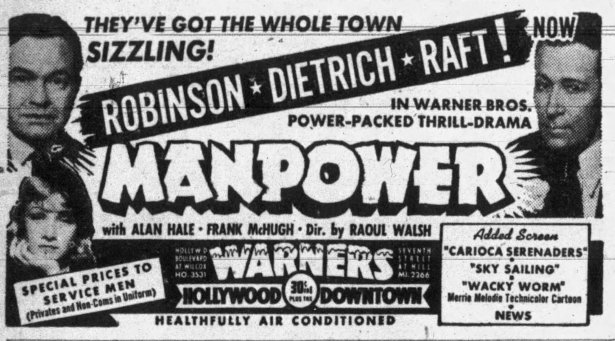
Ad for the LA release of Manpower, July 18, 1941.

Raft and Dietrich in Manpower (1941).

The Manpower bar scene from Bugsy (1991).

Virginia Hill with Raft in Manpower (1941).

The chair-breaking scene from Manpower in Bugsy (1991).
Afterward, George is driving Siegel through Beverly Hills to his hotel when Siegel asks him to stop at the home of opera singer Lawrence Tibbett. Siegel hands Tibbett a pile of cash for the home and buys it on the spot. In reality, the Siegel family may have rented the Tibbett abode for a brief time. However, Tibbett was no longer its resident at the time. Born in 1896, he was also younger than his fictional counterpart.
Tibbett’s house that the Siegels rented was at 933 N. Rexford Drive. Strangely, it was next door to the residence of the late Charles Crawford, who had lived at 929 N. Rexford Drive. Tibbett and his first wife Grace bought 933 N. Rexford in October 1929 when Tibbett was making movies for MGM. The couple publicly separated in July 1931 and Lawrence Tibbett moved out.
The house used in 1991’s Bugsy as Tibbett’s home is not 933 N. Rexford Drive. It is located in Pasadena.
By October 1937, Siegel was building a large home for his family on Delfern Drive in exclusive Holmby Hills. It was completed in 1938 and occupied by the family until Ben and Esta Siegel separated in 1944. See my previous post, Bugsy Siegel In Los Angeles Pt. II.

Lawrence Tibbett in 1943.
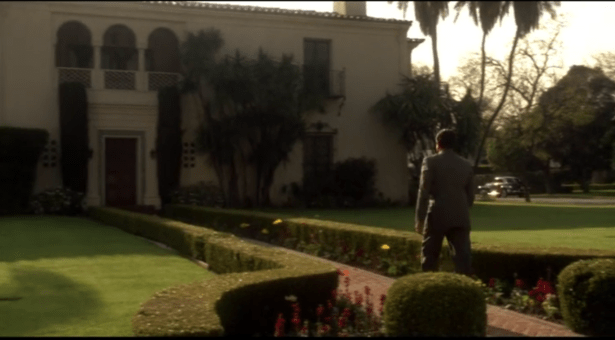
Bugsy makes Lawrence Tibbett an offer he can’t refuse in a fictional scene.

933 N. Rexford Dr. was designed by Marshall P. Wilkinson in 1924 for Graham L. Sterling. Lawrence Tibbett bought it in October 1929. LAT 10-5-1924.

Howdy neighbor! LA crime boss Charles Crawford lived next door to Lawrence and Grace Tibbett at 929 N. Rexford Drive. Crawford was murdered in May 1931 and Tibbett moved out of 933 in July of that year. LAT photo.
In the film, Siegel then meets with Jack Dragna at his home to discuss Siegel taking over his bookmaking operations. Accounts of Siegel’s takeover are sketchy and unreliable at best. However, it’s clear that in 1937 Siegel with Dragna’s grudging help was squeezing out the Guy McAfee/ Tutor Scherer/ Farmer Page/ Zeke Caress LA mob. The attempted and ultimately successful murder of Les Bruneman, a one-time henchman of Farmer Page’s in Page’s bootleg Trust days, is likely also related. At the same time, the citizen-led reform effort of CIVIC and cafeteria owner Clifford Clinton was underway. My previous post on that can be found here. By June 1939 McAfee et al had showily decamped for Las Vegas (though they retained underworld ties to LA) ostensibly due to new mayor Fletcher Bowron’s reform policies. While that may have been part of it, it was widely hinted at the time that they had been squeezed out by a new man in town: Siegel.
In Bugsy, Siegel is in with the Hollywood crowd, hanging out at Ciro’s on the Sunset Strip, pursuing Virginia Hill and rubbing elbows with the American Italian countess by marriage, Dorothy di Frasso. Dorothy di Frasso was a real person. She and Siegel had made a strange and ill-fated sea voyage together in 1938.
Ciro’s was opened by Billy Wilkerson at 8433 Sunset Boulevard on January 30, 1940. A society column about Siegel from the Los Angeles Examiner (a real paper at that time) is fictional. It reads “Gangster or Star? Rackets King in Social Swirl” and refers to Siegel as “the ever dapper Bugsy Siegel.” “I’m a sportsman,” Siegel is quoted as saying in the piece. The Examiner was ahead of other local papers in exposing sportsman Siegel as a New York racketeer. The Crime Commission later wrote a blistering admonishment of how easily the gangster was taken under Hollywood’s wing.
One issue with the fictional timeline in the film: this article is dated January 4, 1945! Later in the film, Cohen reads an article dated 1944.
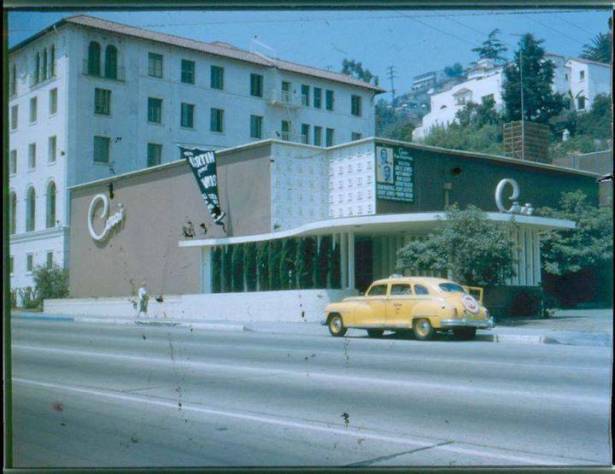
Ciro’s, 8433 Sunset.
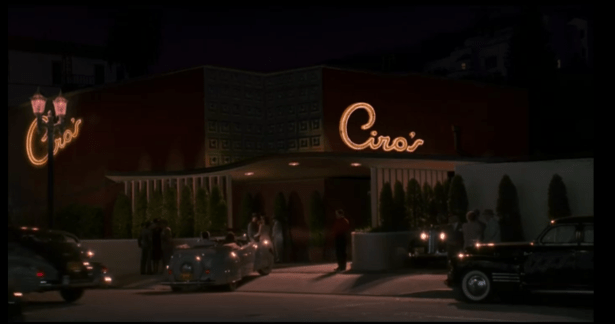
Ciro’s in Bugsy (1991).

Society column seen in Bugsy, a fictional Los Angeles Examiner piece dated 1-4-1945. Oops!
In the film, at Ciro’s, Siegel is seen talking to DA “James McWilde” who is up for relection. Siegel expresses a desire to contribute to the campaign and McWilde refers him to his aid to arrange a donation. LA had no DA McWilde. The DA from 1928 to 1940 was Buron Fitts. Fitts was finally defeated by John F. Dockweiler in November 1940. Siegel was in jail on murder charges at the time. He did make a donation to the campaign of Dockweiler, who would now be in charge of Siegel’s case. Dockweiler, however, was not corrupt and could not be bought. Really. When he learned of the donation, he returned it. The LA mob wanted to get rid of Dockweiler in the worst way. See my post on Mumsie McGonigle, here. Dockweiler, though a young man, died in office on January 31, 1943. Fred N. Howser, who much more to the underworld’s liking, was appointed to replace him on February 2, 1943.
In the film, Jack Dragna calls Siegel to report that Mickey Cohen had just held up Dragna’s Franklin Street bookie joint for $56,000. Siegel drives over there. The location he visits, pretty faithfully recreated here, is Vine Street, however, not Franklin.

Vine Street as seen in Bugsy (1991).
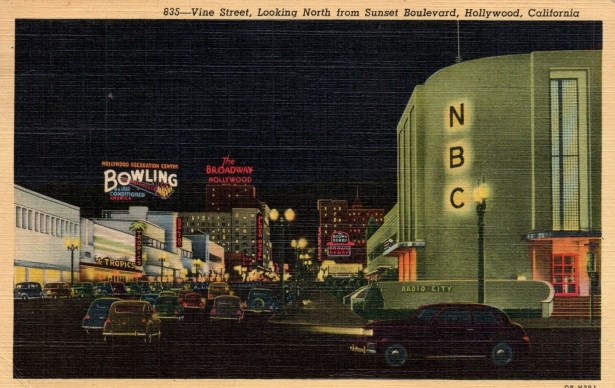
In this scene, Bugsy observes a “Back the Attack” war bond rally going on across the street from Dragna’s bookie joint. “Back the Attack” was the real slogan of the 1943 war bond drive, which kicked off in September of that year.

“Back the Attack” war bond rally in Bugsy (1991).

“Back the Attack” was the slogan of the 1943 war bond drive, which began September 24, 1943.
As for the robbery, Cohen described the incident. It’s his version of events. The way the film depicts him, as a near-equal to Siegel, is not accurate as noted above. In the bar meeting of Cohen and Siegel, Cohen mentions he dates stars like Ava Garder or Betty Grable. George Raft, whose fictional counterpart lets this remark pass without comment, dated Betty Grable in real life. In his “as told to” memoir, Cohen describes holding up a gambling joint run by the LA mob’s Eddie Nealis. Grable was present but as Cohen tells it, he didn’t recognize her. See my post about this robbery, here.

Betty Grable and then-squeeze George Raft.

In Bugsy (1991), Bugsy and George meet Cohen at the Biltmore basement pool and fitness center.
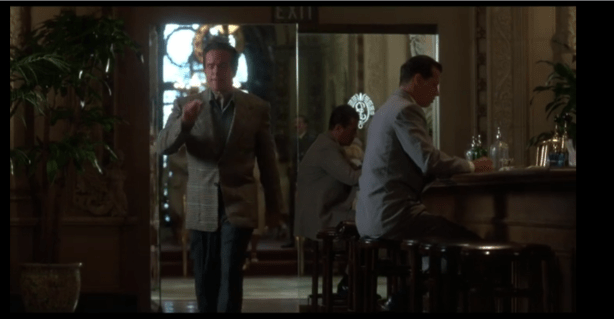
In Bugsy (1991) Siegel negotiates a deal with Cohen in the Biltmore bar.
In the film, Virginia Hill, Siegel and Cohen go to Las Vegas. The depiction of Vegas as a sleepy berg with dirt streets and run-down casino is a far cry from reality. Wartime Las Vegas was booming. Siegel’s LA rivals, Guy McAfee, Tutor Scherer and Farmer Page, had established legitimate casinos downtown on Fremont Street by 1942. Siegel’s interest in Las Vegas was related to the race wire. Nevada had legalized off-track betting in 1941. Any Las Vegas casino that wanted to offer betting on horse races had to subscribe to the Siegel-controlled race wire. Moe Sedway (who has a fictional counterpart in Bugsy) fronted for Siegel in this venture. See my previous post on the race wire situation.
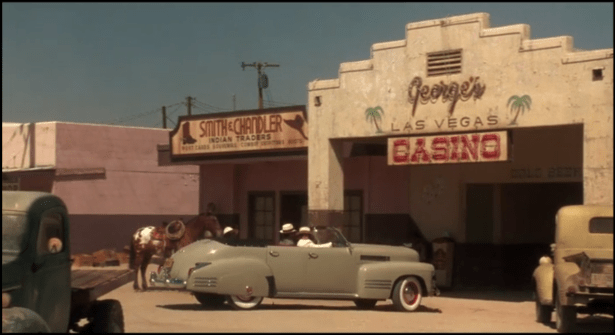
Las Vegas as depicted in Bugsy (1991). Note the “Smith & Chandler Indian Traders” storefront.

The 100 block of Fremont Street, Las Vegas, c. 1943. Note the real Smith & Chandler Indian Traders storefront.

Fremont St. Las Vegas c. 1943
On the return trip to LA, Bugsy’s Siegel has a vision in the deserted desert of building an oasis- a resort hotel casino. Great idea! Only Tommy Hull thought of it first. He opened El Rancho Vegas, the first hotel on what later became the Las Vegas Strip, in April 1941. My previous post on El Rancho Vegas can be found here. The second hotel on the Strip was the Last Frontier, built on the site of a previous club owned by Guy McAfee. There were also numerous small motels, nightclubs and restaurants along this stretch of what was then Highway 91.

Bugsy has an epiphany in Bugsy (1991).
As the film continues, Siegel and Cohen are seen at Union Station with Siegel departing for New York to “visit” Esta and ask for a divorce. Cohen is reading the LA Times, a headline story about “Un-lucky” Luciano and stoolie Harry Greenberg. “Greenie canery sings Charlie into his cage.” The date reads March 30, 1944.
In real life, Luciano had been in prison since 1936 (and Harry Greenberg had nothing to do with that). Harry Greenberg was killed in November 1939. Greenberg had been demanding money for his silence in the 1930s when New York’s “gangbuster” Thomas Dewey was prosecuting Murder, Inc. boss Louis (Lepke) Buchalter for labor racketteering, then went on the lam. Another “stoolie,” Abe Relles, who was in a position to convict both Siegel and Buchalter for Greenberg’s murder, had “fallen” out of a window in 1941. The Luciano character in Bugsy seems to be a meld of Luciano and Buchalter, though the time-frame still doesn’t work.
In real life, as noted earlier, Esta and the girls lived with Siegel in Beverly Hills.

Union Station in Bugsy (1991).

Fictional LAT Harry Greenberg headline dated March 30, 1944 from Bugsy (1991).
On returning to LA, he finds Virginia’s brother Chick visiting. Chick Hill was an actual person. Siegel puts Hill in charge of planning the Flamingo.

Drawing of the plan for The Flamingo in Bugsy (1991).
The role of former Ciro’s owner Billy Wilkerson in the Flamingo operation isn’t mentioned. Del Webb, the contractor depicted in the film, was a real person. The original name of the project was The Flamingo Club.
In this scene, Siegel is reading the LA Times newspaper about the murder of Italian dictator, Beinito Mussolini, which occurred on April 28, 1945. The headline and photo have been changed, but the paper shown in the film is the actual LA Times front page from April 30, 1945. The adjacent stories are actual articles published that day.

Siegel reads of Mussolini’s death in Bugsy (1991).
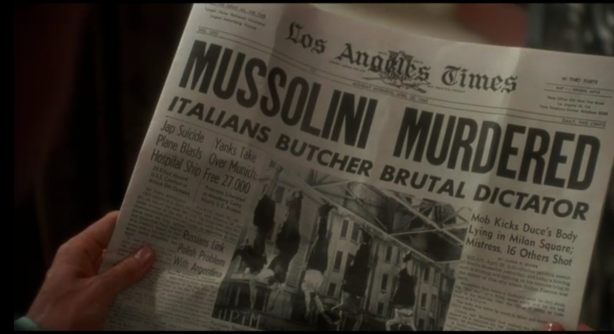
Close up of the Mussolini story in Bugsy (1991).

The actual front page of the LA Times 4-30-1945, reporting Mussolini’s death.
As the film continues, Harry Greenberg arrives at Siegel’s house in a taxi. Siegel takes him for a ride. In real life, as noted previously, Harry Greenberg was murdered in November 1939 while sitting in his car parked out in front of his house. He’s been hiding out from Siegel and the New York mob- he certainly wouldn’t seek out Siegel! His presence in Hollywood was inadvertantly exposed by the LA Times, when it ran a human-interest story about the chance meeting of Greenberg’s wife and her long-lost sister at the corner of Hollywood and Vine- conveniently listing Greenberg’s address in the piece. As Siegel is seen reading the paper so often in Bugsy, this would have been a fabulous and more true to life scene to recreate- though problematic since Bugsy’s Harry Greenberg is sort of a combo of both Harry Greenberg and Abe Relles and therefore could not be both the murder victim and witness who could link Siegel to said murder.

This random article in the September 21, 1939 LA Times likely sealed Harry Greenberg’s fate.
The film’s Siegel goes back to New York to attend a “deportation party” for Charlie Luciano and while there he and Esta call it quits.
Thomas Dewey, who had successfully prosecuted Luciano in 1936, was elected governor of New York in 1943 and in 1945 commuted Luciano’s sentance, ostensibly in exchange for Luciano’s wartime behind the scenes assistance to the Allies. The film timeline is mixed up here. Mussolini’s death was in April 1945. Luciano was deported on February 10, 1946. His “bon voyage” party in New York coincides with Siegel and Esta agreeing to divorce as well as the Japanese surrender. The latter occurred August 14, 1945. The Siegels agreed to separate in June 1944 and it was at that time that Esta and the girls moved back to New York.

Fort Worth Star-Telegram story on Luciano’s deportation. 2-11-1946.
Back on the Coast, with the war over, contruction is underway on the Flamingo. In real life, constuction began, to some extent, in December 1945. But with building materials in short supply and a high priority for veterans’ housing, non-essential building was soon halted by the Civilian Production Administration (CPA), the successor to the War Production Board, created in October 1945. Read more about the CPA in my previous posts here and here. Siegel wrangled with the CPA and at one point constuction was halted while a hearing was held on the matter in San Francisco. Ultimately, the Flamingo was given the go-ahead to proceed.
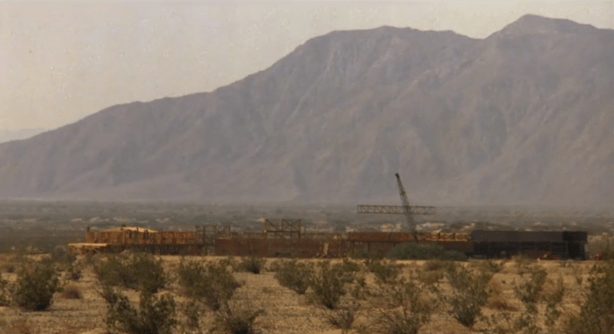
The Flamingo under construction in Bugsy (1991).

Flamingo construction 1946.
In the film, Federal Marshals arrive at the construction site to arrest Siegel for the murder of Harry Greenberg. In reality, Siegel was charged in Big Greenie’s murder on August 16, 1940 at his Delfern Drive mansion, let go, and arrested again on October 10, 1941.
In the film, the taxi driver who brought fictional Harry to Siegel’s house is a key witness and is spirited out of town (with help from Cohen and the corrupt DA) so he can’t testify. In reality there was no taxi driver. The key witness was Abe Relles, who “fell” out of his window, never to sing again. Another witness, Al Tannenbaum, testified to Siegel’s personal involvement in Greenberg’s murder- but as a con-conspirator, Tannenbaum’s testimony alone could not convict and Siegel was indeed let off “scot-free” as the movie depicts. That much was true.
Also true was the special treatment Siegel received while in the County Jail awaiting trial. He had meals delivered from Ciro’s and the jail doctor, a pal he met at Countess di Frasso’s, Dr. Benjamin Blank, allowed Siegel out of jail for supposed medical reasons as many as 18 times. It’s unlikely Hill really joined him in his cell for dinner, but on one of his visits to the outside, he was spotted having lunch at Lindy’s on Wilshire Boulevard with actress Wendy Barrie.
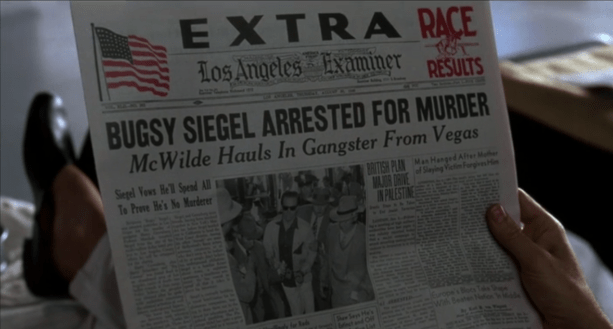
Los Angeles Examiner fictional headline announcing Siegel’s arrest in Bugsy (1991).
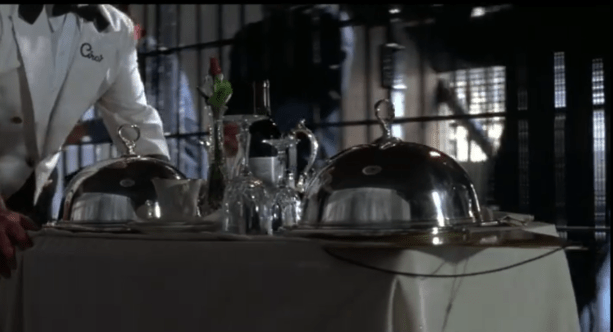
Siegel getting a meal from Ciro’s while in jail in Bugsy (1991).
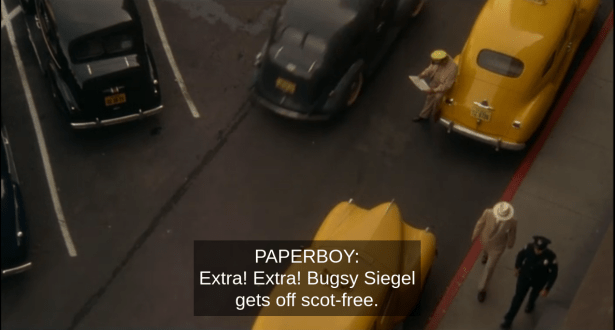
Bugsy beats the wrap. Screen shot from Bugsy (1991).
Freed, it’s full steam ahead for the Flamingo, which Bugsy told reporters is opening Christmas Day. To raise cash, he sells his house and the contents. In fact, Siegel did put Delfern Drive on the market – in June 1944- after Esta moved back to New York. (Her divorce was granted in Reno in August 1946).
The filmmakers did a great job recreating 1946’s Flamingo casino building (the seperate hotel structure isn’t shown). The Flamingo vertical sign, however, capped by a neon Flamingo, is not the signage that existed in Siegel’s lifetime. It is actually the second sign, added circa 1948-1949. The original sign, shown below, was a pylon with neon on either side. The highway frontage sign also appears to be one that was added later c. 1948-1949.

Bugsy’s house is not a home in Bugsy (1991).
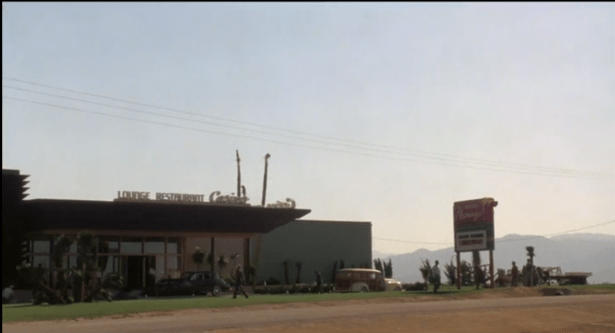
The Flamingo under construction in Bugsy (1991).

Signage for The Flamingo in Bugsy (1991). “Grand opening Christmas.”

Bugsy directs the Flamingo sign in Bugsy (1991)
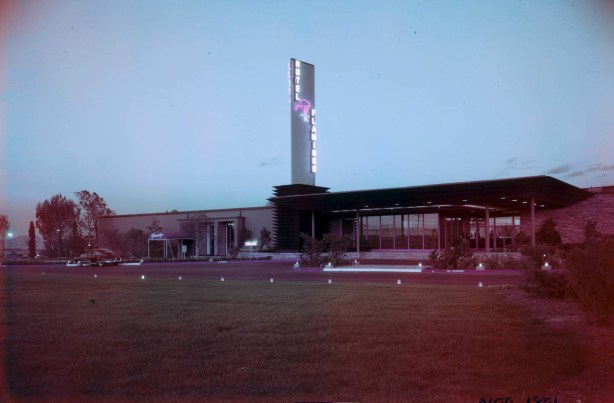
The real club Flamingo on its opening day, December 1946.
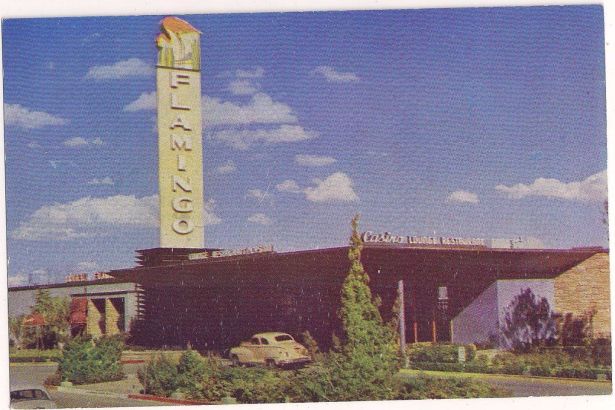
The Flamingo in 1948. Postcard view. This version of the Flamingo sign was the one depicted in Bugsy.

The Flamingo in 1949.
Meanwhile, the film has Cohen warning Bugsy that Virginia has a Swiss bank account with $2 million in it. The exiled Luciano, still running the outfit from afar, has gathered the “boys” in Cuba for a meeting at the Hotel Nacional to complain about Siegel’s cost overruns for the Flamingo. Lansky advocates giving him a chance to make good. Uh-oh.

Pasadena’s Castle Green stands in for Cuba’s Hotel Nacional in Bugsy (1991).
It’s the Flamingo’s opening night, December 25, 1946. It’s a bust. No patrons in sight. The celeb guests are no-shows, grounded by a terrible rain storm. Virginia is absent- having fought with Siegel after he confronted her about the $2 million. Siegel announces on the spot that the casino is shutting down temporarily.

The Flamingo on opening night, 12-25-1946 in Bugsy (1991).

An empty Flamingo on opening night in Bugsy (1991).

Flamingo neon in Bugsy (1991).
Ok. In real life, the Flamingo had a 3-day gala opening December 26, 27, and 28 1946. Virginia was there (as was Billy Wilkerson) with a different hair color and fabulous designer gown for each evening. It was well attended by locals (including rival Guy McAfee and his former starlet wife June Brewster who broke the bank) and some celebs. Critics wrote glowingly of the fabulous decor, comparing it to a Hollywood movie set. (Also the rainstorm that some celebs used as an excuse not to come was in Los Angeles). Financially it was a bust. The hotel portion of the resort was not yet open. The casino continued in business for a few weeks, then it shut down, reopening n March 1947.

Opening ad for The Flamingo in the LA papers, 12-25-1946.
As the movie winds to a close, Virginia and Siegel make up. She admits to skimming the $2 million and offers to give it back. Siegel tells her to hang on to it. He flies back to LA that very evening, Christmas night, for a meeting with the boys. Cohen, who was at the opening in Las Vegas, somehow beats him to LA, and drives him to Virginia’s house. While reading the newspaper, he is gunned down through the window by multiple assailants and collapses on Virginia’s floral couch.
As everyone knows, in real life, Siegel was killed on June 20, 1947. He was not alone. Pal Al Smiley was next to him on the couch and Chick Hill and his girlfriend (Virginia’s former secretary) were upstairs at the time.

Bugsy senses something is up in Bugsy (1991).
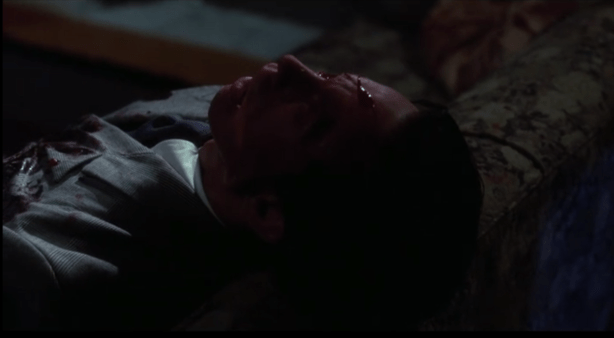
Bugsy is fatally wounded in Bugsy (1991).

Bugsy in death from Life 7-7-1947.

Life’s 7-7-1947 coverage of Bugsy’s execution includes a photo of the Flamingo as the sign looked in Siegel’s lifetime. The real Countess di Frasso is shown in the lower left. Siegel is pictured with Raft in the upper middle image.
Siegel’s death indeed took place at Virginia Hill’s rented house, which was located at 810 N. Linden Drive. It’s not the house depicted in the film.
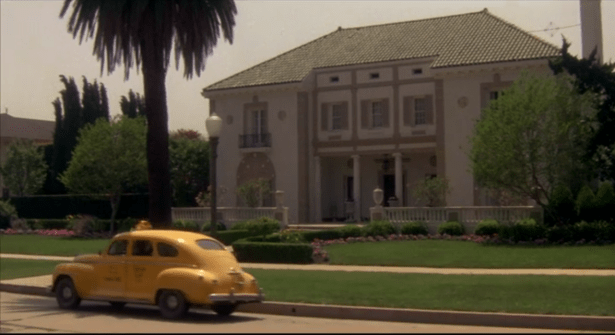
Virginia’s house in Bugsy (1991).
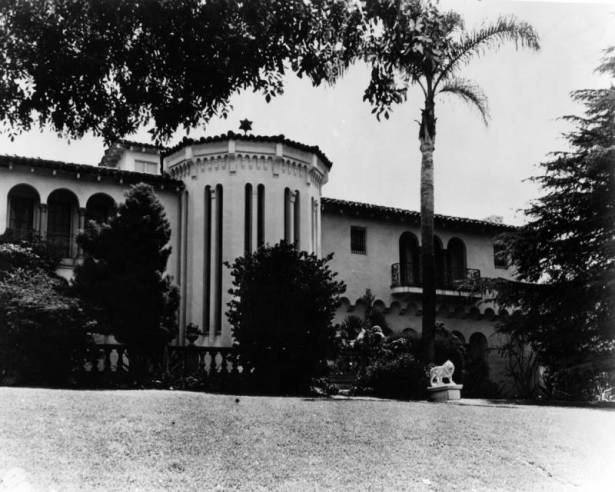
Virginia Hill’s rented house where Siegel was killed. LAPL photo.
In the film, Moe Sedway and Gus Greenbaum arrive at the Flamingo to announce they’re taking over and tell Virginia of Siegel’s death. They did arrive the same day as the murder and took over. However, Hill was Paris at the time of Siegel’s death. The film ends by telling us Virginia gave the $2 million back to Lansky and also informs us she died by suicide in Austria. Which she did- in 1966. There’s no evidence that she stole money or that the Flamingo finances was the motive for Siegel’s execution. The race wire is a more likely scenario, but a less romantic one.

Moe and Gus arrive at the Flamingo to take charge in Bugsy (1991). It’s still Christmas day (note the lights).
A select Siegel timeline 1936-1947
1936
Jan 18 New head of the State Board of Equalization (SBE) recommends yanking the Clover Club’s license over gambling. Run by Farmer Page/Eddie Nealis at 8477 Sunset. Coincident is an ongoing scandal involving club owners accusing the SBE of supposedly accepting payoffs.
May Clover Club apparently closed having lost its liquor license; trial is held in the payoff case.
Jun 5 Clover Club’s license restored.
Jun 5 Charles Luciano convicted in New York on more than 30 counts of compulsory prostitution and is sent to state prison.
1937
Feb 3 Clover Club raided by LA Sheriff’s vice squad led by George Contreras, arrests made for liquor violations.
Jul 19 George (Les) Bruneman, bookie and gambling club operator, shot but lives.
Jul 20 A combined team of law enforcement makes a huge sweep of bookies and gangsters in relation to the Bruneman shooting. CIVIC pushes for an independent vice inquiry led by grand jurist and cafeteria chain owner Clifford Clinton while Mayor Shaw denies that Los Angeles is “wide open.”
Aug 1 Grand jury inquiry into gambling seeks Eddie Nealis, Tutor Scherer, Guy McAfee, Johnny Roselli, Jack Dragna and others. To be quizzed about the Bruneman shooting as well.
Aug 4 SBE suspends the Clover Club’s liquor license over gambling activity.
Oct 10 LAT reports that “Ben Siegel” is building a home on Delfern Dr. in Holmby Hills. Indeed, Bugsy’s house at 250 Delfern is completed by 1938.
Oct 24 still-recovering gambler Les Bruneman gunned down at Topsy’s café.
Nov 15 “delicatessen operator” and bookmaker Hymie Miller, an ex-boxer, is shot at his home on Hollywood, 1644 N. Cahuenga.
Dec 12 Phil Selznick opens Club Versailles at 8588 Sunset. This is supposedly the club madam Lee Francis was planning to open; she was denied a permit at the last minute. Some speculation that a mobster took it over- possibly Bugsy. Still Versailles thru Feb 1939 at least.
Dec Clover Club has mysteriously reopened.
1938
Feb Assembly Committee in Sacramento wants to know how the Clover Club came to get its license back, but unable to serve a subpoena on any owner or operator.
Mar Recall effort of Mayor Shaw begins; he blames “eastern vice interests” as the reason behind it.
May 5 Tony Cornero’s REX gambling ship opens off Santa Monica. Bugsy claims to be an investor
May 6 Wilkerson’s sale of Café Trocadero to Nola Hahn made public.
May 18 Nola Hahn of the Clover Club, reopens 8610 The Trocadero (supposedly a front for Farmer Page/Nealis).
Sep Bookie John Osborne claims he opened his bookie joint at Santa Monica Blvd & La Brea Ave. under protection of gambling boss Eddie Nealis. He says this is how it was up until the time he was raided November 1939.
Sep 21 Hollywood “sportsman,” Bugsy cruises on the Metha Nelson with Countess Dorothy di Frasso, Marino Bello (stepfather of the late Jean Harlow), county jail’s Dr. Blank and others.
Sep 26 Mayor Shaw ousted in a recall effort & Mayor Fletcher Bowron takes office.
Nov 11 Bugsy abandons the Metha Nelson trip and flies home.
Nov 16 Clover Club’s liquor license pulled (again) by SBE over gambling activity.
Nov 21 Billy Wilkerson’s Vendome at 6666 Sunset sold at auction.
Dec 28 Bookie Weldon “Duckie” Irvin found murdered in the 6000 block of Selma, Hollywood, believed to have been killed a couple days earlier. Suspected of selling “phony juice” (worthless police protection). A number of vice and robbery officers conducting the latest series of raids report that their prisoner seemed “genuinely surprised” at being arrested. Some claimed they were “paid up” for protection and were amazed when their places were raided. A well known Italian bookie arrested several days earlier was heard to remark “somebody is going to have to answer a lot of questions for me!”
Dec 29 8433 Sunset (future Ciro’s location) opens as the new Marcel Lamaze Restaurant.
1939
Jan 10 Metha Nelson captain back home in LA charges Bugsy’s friend and erstwhile crewmember Harry “Champ” Segal with mutiny. grand jury declines to issue indictments. The matter drops
Jan 19 Feds raid Bugsy’s “palatial home” on Delfern in search of smuggled perfume. Find nothing.
Feb 6 Ruby Foo’s opens in the former Vendome space. Mickey Cohen later states it was over dinner at Ruby Foo’s that he made a deal with LAPD head of Vice to open a bookie joint.
Mar 5 Eddie Cantor gift shop at 1630 N. Vine, where Champ Segal’s La Grand Prix barber shop would be, is sold at auction.
Apr 8 Bugsy testifies in 1941 that he sailed for Naples this day and that he returned by June 6.
Jun 1 LA Times reports gamblers like Guy McAfee fleeing to Las Vegas as LA was becoming a “tight” town and county. Eddie Nealis of the Clover Club, “which had been closed for several months,” said to be in San Francisco; Famer Page said to be on a gambling ship.
Jun 6 Bugsy returns to US from Naples per 1941 testimony.
Aug 19 Bugsy testified in 1941 that he flew to NY this day.
Aug 20-24 Bugsy in New Jersey shore with Esta and kids.
Aug 25 Bugsy in New York per grand jury subpena.
Sep 16 Countess di Frasso travels home from Naples per passenger list.
Oct 7 Felix Young abruptly closes the Trocadero, which is thrown into involuntary bankrupsy.
Nov 13 Mickey Cohen, said to be manager of a bookie joint at 5536-1/2 Santa Monica Blvd., arrested along with Joe Sica and others on suspicion of burglary. Capt. Stanley Stone, LAPD led raid.
Nov 15 Cohen released, per FBI report.
November 15 Moses Anneburg gives up his Nationwide News Service race wire, which had been run by his associate James Ragen Sr.
Nov 20 Nationwide News Service comes into existence, owned by Arthur B. “Mickey” McBride, run by James Ragen, Jr., who’s father Ragan St. ran Continental.
Nov 22 Eastern gangster Big Greenie murdered in Hollywood. Stanley Stone was one of the LAPD detectives working “one angle of the case.” (By 1944 Stone works for the D.A.)
Nov 24 Bookie John Osborne claims his bookie joint at Santa Monica & La Brea avenues was raided and shut down.
Dec 29 Trocadero reopens. Ownership and management listed as John Steinberg.
1940
Jan 30 Billy Wilkerson opens Ciro’s at 8433 Sunset.
Jan 17 Lee Francis arrested for the first time in 31 years at 8439 Sunset next door to Ciro’s. Dep Sheriff Charles Rittenhouse makes the bust.
Mar 24 Clover Club at 8477 is raided by sheriff.
Apr 22 Ann Forrester arrested, accused of pandering in huge “white slave” vice ring.
May 7 Atty Gen Warren issues sweeping indictment of all known bookie establishments, including M.H Cohn.
May 13 Trocadero and contents auctioned off.
May 23 Cohen arrested for assault with a deadly weapon and vagrancy per DN/FBI (hereafter FBI)
May 27 Cohen released from this charge on a writ of habeas corpus. Rebooked same day on different charges.
Jun 24 Cohen released; charges of May 27 dismissed per FBI
Aug 1 Benjamin “Whitey” Krakower murdered in NY.
Aug 16 Bugsy arrested at Delfern Dr. for 1939 murder of “Big Greenie.”
Oct 6 Cohen registers per the Selective Service Act as MICKEY MICHAEL COHEN.
Oct 15 Cohen marries Lavone Weaver.
Nov 5 John F. Dockweiler beats Buron Fitts for D.A.
Nov 8 Bugsy- ostensibly in jail- seen having lunch at Lindy’s on Wilshire Blvd. with actress Wendy Barrie. Raymond Chandler fictionalized this incident in The Little Sister.
Nov 8 Mickey Cohen (as “Micky Cohn”), Joe Sica and Al Smiley arrested on suspicion of burglary. Smiley had just been questioned and released in the Big Greenie case is mentioned. Stanley Stone is again the officer in charge. Per LAPD records. LA Times.
Nov 14 Cohen released on a writ per FBI
Dec 19 Story breaks that Bugsy had been out of jail 18 times since his Aug 16 arrest.
Dec 20 George Contreras removed as head of Sheriff’s vice squad which he’d headed since 1933. Ray Morris becomes chief of vice while Contreras goes to the subversive activities unit.
1941
Jan 3 Mocambo opens in the former Club Versailles, 8588 Sunset, run by Charlie Morrison and Felix Young.
Feb 4 Cohen arrested for bookmaking violation of California Penal Code 337 A and received a six-month sentence in a $100 fine. (he appeals and won’t do time until 1942). FBI LAPD records.
Apr 17 Bugsy indicted in New York on charges of harboring racketeer Louis (Lepke) Buchalter arrested in LA and freed on bond.
Apr 21 Bugsy, facing charges of harboring Lepke Buchalter is allowed to leave the country to go to Mexico on “business” promising to return for his May 12 hearing.
May Sheriff’s deputy Charles Rittenhouse and George Contreas implicated in Sunset Strip “pay off” scandal. Bookie Mike Shapiro of 1130 N. La Brea indicted for bribing Rittenhouse. Bookie John Osborne testified to paying off Rittenhouse through Eddie Nealis.
June 6 Eddie Nealis said to be in Mexico City. His draft registration, completed in 1941, list Mexico City as his address. He was president of the Agua Caliente jockey club.
Jul 11 Cohen appeals the bookmaking charge. FBI
Sept Cohen arrested and held for questioning in connection with an attempted murder of Benny Gamson while under appeal bond on the bookmaking offense. FBI
Sept 22 Siegel reindicted by the LA County grand jury for murder of Big Greenie.
Sep 23 Nationwide search for Bugsy. Friends say he’s on vacation “somewhere in Nevada.”
Oct 10 Bugsy again arrested in connection with murder of Big Greenie.
Nov 12 Abe Reles (aka Kid Twist), hitman of Murder, Inc. who was to testify against Bugsy in the Big Greenie case mysteriously “falls” while assertedly trying to “escape” from protective custody at hotel in New York.
1942
Jan 19 Bugsy’s trial for Big Greenie murder gets underway. Bugsy had no doubt been expecting the charged to be dismissed without a trial.
Jan 28 Cohen surrenders to being serving his 6 month sentence on the Feb 1941 bookmaking charge.
Feb 6 Murder charges against Bugsy dismissed on basis of lack of corroborating testimony due to death of key witness Abe Reles.
Mar 22 Bugsy returns to LA from Mexico on a trip of unknown duration.
Apr 28 Cohen, serving his six-month sentence at the County Jail, questioned by the feds about a gun found at his joint with its numbers filed off.
Jun 26 Cohen released from County Jail.
Jul 21 With accomplice Joe Sica, Cohen rips out the racing wires at Al Green’s bookie joint, 1057 S. San Pedro St. and Continental Press Service’s LA racing wire HQ, 208 W. 8th St. run by James Ragen’s son-in-law Russell Brophy; beats Brophy. Cohen claims he went to Arizona to hide out.
Jul 30 arrest warrant issued for Cohen. FBI
Aug 17 Grand Jury indictment was effected for Cohen. FBI
Sep 25 Mickey Cohen surrenders to police and faces charges in the Brophy matter. Trial set for Nov 4.
Sep 27 Capt. William T. Deal replaces Ray Morris as head of the sheriff’s vice squad “for the duration,” as Morris joined the Merchant Marines.
Nov Wilkerson leases Ciro’s to Herbert D. “Herman” Hover and Marcel LaMaze.
1943
Jan 31 D.A. John F. Dockweiler dies in office.
Feb 2 Fred N. Howser appointed D.A.
Feb 8 Cohen permitted to plead guilty in the Brophy matter to a lesser misdemeanor and fined $100.
Mar 4 Tommy Hull of El Rancho Vegas tells Las Vegas Review Journal that he refused to sell El Rancho to Bugsy. Later this years sells it to Tom Drown.
Mar 17 Cohen arrested by LAPD for violation of Municipal Code 43.01 (shooting craps), fined $5. FBI LAPD
Apr 21 Trocadero reopens (again), Louis Cantone, manager
Aug 2 Eddie La Baron purported owner of the Trocadero.
Sep 15 8477 Sunset Clover Club reopens (initially as “Club Lamaze” but soon Clover Club) run by Marcel LaMaze.
1944
Mar 22 Mrs. Fred Payne, leases her mansion at 9100 Hazen Dr. in Coldwater Canyon to a Toni Hughes. Later court testimony contends Hughes had worked as a waitress in the Cohen-run La Brea Social Club.
Apr 16 Residents near 9100 Hazen block the road leading to the hilltop mansion and telling the 25-30 cars headed up there that way that the place was going to be raided and names of patrons were wanted for evidence. The cars turned back. Raymond Chandler fictionalized the incident in The Little Sister.
May 11 City Attorney Ray L. Chesebro held a “special hearing” to review the 9100 Hazen matter, at the conclusion of which he dismissed the case and reprimanded the neighbors for taking the law into their own hands, noting that THEY had violated several sections of the Penal Code. Hughes had, however, moved out.
May 25 Bugsy arrested with Al Smiley at Sunset Towers 8358 Sunset for felony bookmaking by William T. Deal of the Sheriff’s vice squad.
Jun Bugsy and Esta separate. She moved back to New York. He moved in with his sister at 721 N Doheny Dr. (gives updated address to draft board) but spent most of his nights in various rented digs with Virginia Hill.
Bugsy sells Delfern Drive house to Loretta Young for $85,000.
Jun 16 Mrs. Cohen reports a burglary at the couple’s home. Says Mickey kept money there. Mickey refuses to let a police report be made. Investigation made by the Beverly Hills Police Department notes it was rumored at the time that Gibbons was the person who had broken into Cohen’s home.
Jun 28 Bugsy and Al appear in court to plead in the bookmaking case. Bugsy driving a red convertible coupe.
Jun 28 Jack Dragna denied citizenship. His 1930 arrest with sawed-off shotguns cited as reason.
Jul 17 George Raft testifies on Bugsy’s behalf in the bookmaking trial.
Aug 8 Al Smiley involved in the “balcony battle” with Tommy Dorsey and actor Jon Hall.
Aug 16 Bugsy sues Loretta Young for backing out of home purchase.
Sept Cohen arrested by SF police for vagrancy. Permitted for forfeit $1,000 bail and leave town. FBI
Sep 11 Bugsy and Al are fined in the bookmaking case.
Dec Clover Club’s license suspended by SBE over violation of the midnight closing law.
1945
Jan 12 Bugsy loses lawsuit with Loretta Young over sale of Delfern Dr.
Jan 23 Nate Sherry buys the Clover Club from an Ivan Staufer.
Feb Billy Wilkerson buys 33 acres along Hwy 91 in Las Vegas.
Apr 3 Clover Club reopens as Jerry’s Joynt Hollywood. Soon reverts to “New Clover Club.”
Apr 6 Mobsters Moe Sedway, Gus Greenbaum, fronting for Myer Lansky, Bugsy and others, buy the El Cortez in Las Vegas.
Apr Bugsy’s Delfern Dr. house sold to Joseph M. Hammerman
May 15 Mickey Cohen kills rival bookie Max Shaman (operating at 8109 Beverly Blvd) in a brawl. Mickey then operating his La Brea Social Club at 126 N. La Brea Ave.
May 16 Cohen arrested in the Shaman case. Claims self-defense.
May 18 Cohen released after complaint was refused by the Los Angeles County Deputy District Attorney A. S. Colgrove, who determined it to be justifiable homicide. Cohen’s gun was returned to him. He later bragged to intimates that it cost him $40,000 to escape this charge of murder.
May 20 LAT reports that Mickey “fears for his life” and his address is 9938-1/2 Robbins.
Jun Inspector Norris G. Stensland replaces William Deal as head of the sheriff’s vice squad. Deal made head of the Montrose substation.
Jul 1 Dep. Sheriff George Contreras, the corrupt ex-head of the sheriff’s vice squad, dies.
Aug 14 Japan surrenders; WWII ends.
Nov 17 Cohen arrested at 126 N. La Brea along with Harry A. “Hooky” Rothman, Paul Gibbons, and others on suspicion of robbery when 2 stolen guns are found. LAT LAPD
Nov 19 Cohen’s lawyer Sam Rummel gets the case thrown out. The complaint is refused by the Los Angeles County District Attorney and Cohen is released.
Dec Construction begins on Flamingo Club in Las Vegas.
Dec 31 An unnamed gambling club 9216 Sunset Strip robbed at gunpoint. Betty Grable and Harry James are among the celebrity patrons present. The crime goes unreported, but somehow sheriff’s office gets wind of it and runs around in circles trying to identify both the robbers and the club operator(s).
1946
Jan 3 “Writer” Jack Alexander Waer comes forward to identify himself as operator of the club at 9216 Sunset. Admits he has a “silent partner” but declines to name him. The LAT reveals that Eddie Nealis gets mail at that address. In 1951, Waer is described as an associate of Mickey Cohen.
Jan 30 LAT reports that Mickey was arrested at 141 N. La Brea for failing to resister as an ex-convict (no mention of bookmaking). Rudy Wellpot and J.G. Fisk are the arresting officers. FBI report says per LAPD he was arrested this same date for violation of Municipal Code 42.39j Sub A (bookmaking).
Jan 31 LAT reports that Mickey is protesting this latest “beef” and the case was continued to Feb 6.
Jan 31 Clover Club advertises its “re-opening.”
Feb 6 the bookmaking case against Cohen dismissed. per FBI
Feb 10 Charles Luciano deported.
Mar 5 Deed of trust recorded related to Bugsy’s syndicate’s sale of the El Cortez Hotel, though officially the syndicate still owns it until Jul 30.
Mar 15 PAULY GIBBONS suspected of burglarizing COHEN’S home. FBI. LAPD.
Mar 26 Mickey freed on the failure to register charge. LAT.
Mar 28 Reported that Sanford D. Adler, heading a local syndicate, leased El Rancho Vegas from Joe Drown.
Mar 30 Harry “Hooky” Rothman shot by his reputed wife, Lillian Miller, after a bar fight.
Apr 1 Colony House at 9236 Sunset robbed: thieves take its liquor license, a revolver and $2600 cash. Formerly the “Little Troc” operated by gambler Felix Young.
Apr 23 Bugsy, despite having sold Delfern Dr. to another party, had appealed his suit against Loretta Young, but court rules in favor of Loretta today.
May 2 Bookie Paul J. “Paulie” Gibbons, arrested with Cohen back on Nov 19, 1945 is murdered in Beverly Hills. Gambling debts is one theory. Lived with Margo Lux, aka Margaret Krug, a longtime jewel thief. Cohen claims not to know Gibbons, though they found a La Brea Social Club card on the body. Cohen is questioned and released, as is “Meatball” Gamson a few days later.
May 28 Police notice Bennie Gamson’s car shot up with 5 bullet holes and one threw the rear window. He gives conflicting stories about it and is jailed.
Jun 20 Ben and Esta made a financial settlement agreement for the divorce.
Jun 24 Chicago gunmen open fire on 65-year old James Ragen of Continental Press Service; he survives.
Jul 14 Walter Winchell broadcasts about a prominent “West Coast racketeer” attempting to muscle a newspaper publisher out of his interest in a “West Coast hotel.”
Jul 26 Nevada Project Corporation articles of incorporation notorized.
Jul 30 Bugsy’s syndicate officially sell the El Cortez to Ray Salmon and J. Kell Houssells, Sr., having initiated the action back in March.
Jul 31 LAT reports Capone syndicate supposedly has opened offices in the Fergeson Building in downtown LA and were looking to start a rival wire to Transamerican.
Aug 1 Las Vegas Tribune runs a story by Richard King critical of the flamingo for using materials that should have been used for war veteran’s homes.
Aug 3 Mrs Estelle Siegel granted divorce in Reno. Case #103261.
Aug 5 Clark Co. liquor board meeting to decide Flamingo request for liquor and gaming license postponed.
Aug 6 Tony Cornero’s gambling ship Lux opens.
Aug 7 CPA puts a freeze order on Flamingo construction because of the plans had changed since being
submitted to CPA in January and fact that there was now more than 1 building on the property.
Aug 8 The Lux is shut down.
Aug 9 Bugsy in Vegas- tells Lansky over the phone he’s got a hearing in SF over the CPA busines. Clark Co. Liquor Board meets but makes no decision regarding the Flamingo.
Aug 12 Hill taken to the hospital for an operation
Aug 13 Bugsy flies to SF. for the CPA hearing. Stays at St. Francis.
Aug 14 Still hospitalized for his gunshot wounds, James Ragen dies of mercury poisoning.
Aug 14 Bugsy’s gambling and liquor license for Flamingo is granted.
Aug 16 James Utley beaten by Cohen and Joe Sica at Lucey’s restaurant in Hollywood. Involved in a conspiracy to violate the state’s gambling laws case because he ran the bingo concession on the Lux, which had resumed operation.
Aug 26 Bugsy calls reported Richard King about King’s the Aug 1 article and asks “Why doesn’t anybody ask me for my side ask to interview me?”
Aug 27 Golden Nugget News Service on 2nd floor of the Golden Nugget still not completed.
Aug 30 Guy McAfee’s Golden Nugget opened.
Sept FBI source advised that BENNY GAMSON had recently returned from Chicago and was carrying a gun, threatening “to get” COHEN. This source advised GAMSON and GEORGE LEVINSON were interested in certain bookie establishments that had resisted the wire service of BUGSY SIEGEL and MICKEY COHEN.
Sep 2 8477 Sunset, Clover Club holds its “reopening.”
Sept 5 Bugsy in SF for the CPA hearing.
Sep 10 Hedda Hopper’s column mentions a huge nightclub under construction in Las Vegas with Bugsy’s backing, to be called the Flamingo, with 4 swimming pools, to be opened in November, noting how our returning veterans “can’t even get a shed for shelter.”
Sept 14 CPF decides in the Flamingo’s favor.
Oct Trocadero appears to have closed sometime after September, 1946.
Oct 3 Chicago gangster Bennie Gamson and George Levinston executed in Hollywood.
Oct 6 Clover Club raided; “Robert Rubin” is manager.
Oct 19 8477 Sunset, Clover Club advertises “Rumors are flying but the Clover Club is open as usual…” However, it seems to peter out after this. Sherry owns the property until 1952.
Nov 5 D.A. Howser elected State Attorney General.
Nov 12 Lt. Carl Pearson becomes head of the Sheriff’s vice and narcotics squad. Four years later, in Dec 1950, Pearson will be fired over his involvement with mob lawyer Sam Rummel.
Dec 2 William E. Simpson assumes Howser’s unfinished post as D.A.
Dec 7 Jack Dragna, described as a “Hollywood importer,” arrested by the LAPD while attending the fights at Hollywood Legion and held overnight on suspicion of robbery.
Dec 9 Moe Sedway and Bugsy discontinue use of the Continental service in Vegas.
Dec 16 Jack Dragna sues LAPD for false arrest.
Dec 18 D.A. Simpson declares war on eastern gangsters; planning to form his own “gangster squad.” The names of former “gangbuster” Lefty James, and former police chief James E. Davis mentioned as possible heads of this new detail.
Dec 26 The Flamingo Hotel, the third resort hotel-casino on the Strip opens in Las Vegas. Closes shortly after.
1947
Jan 6 Mocambo robbed.
Mar 27 Flamingo re-opens.
May Mickey McBride buys back his interest in Continental. Ostensibly his son, 23 year old Eddie McBride runs it, but it was really the Capone-Lansky mob.
Jun 13 Trans-America wire service announces its going out of business. Legend has it Bugsy refused to shut down and demanded $2 million for it. In 1950 the California Crime Commission report states that Jack Dragna, who ran Continental in partnership with Bugsy, withdrew about 2 weeks before Bugsy’s murder.
Jun 20 Bugsy executed at 810 N. Linden Dr., Hill’s rented home. Chick Hill and Al Smiley are present.
Jul 13 Flamingo Hotel reported sold to Sanford D. (“Sandy”) Adler, who also ran El Rancho Vegas since March 1946.
Oct 22 Governor Earl Warren forms a Crime Commission to study organized crime in the state following the Siegel murder.

